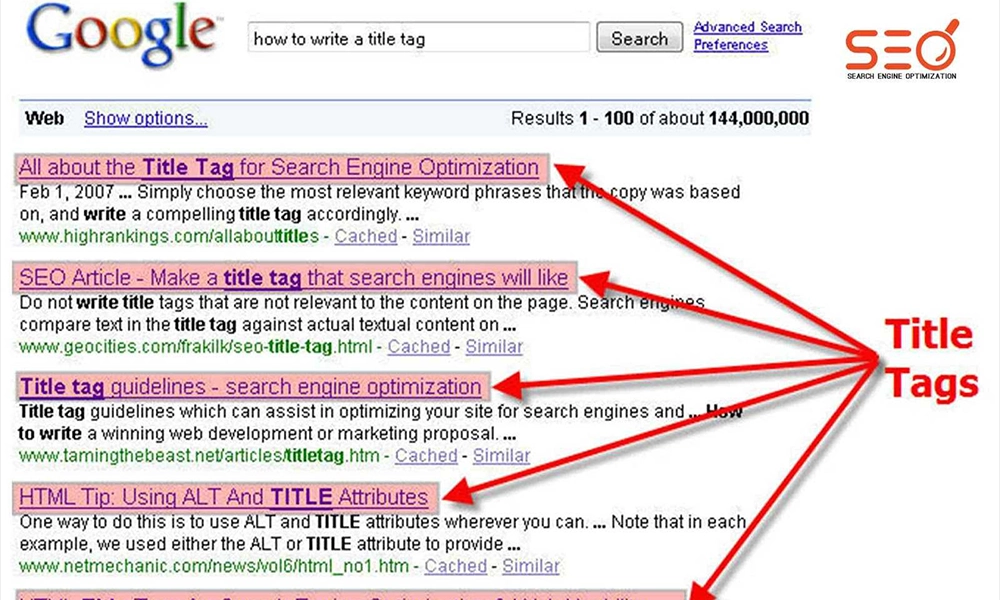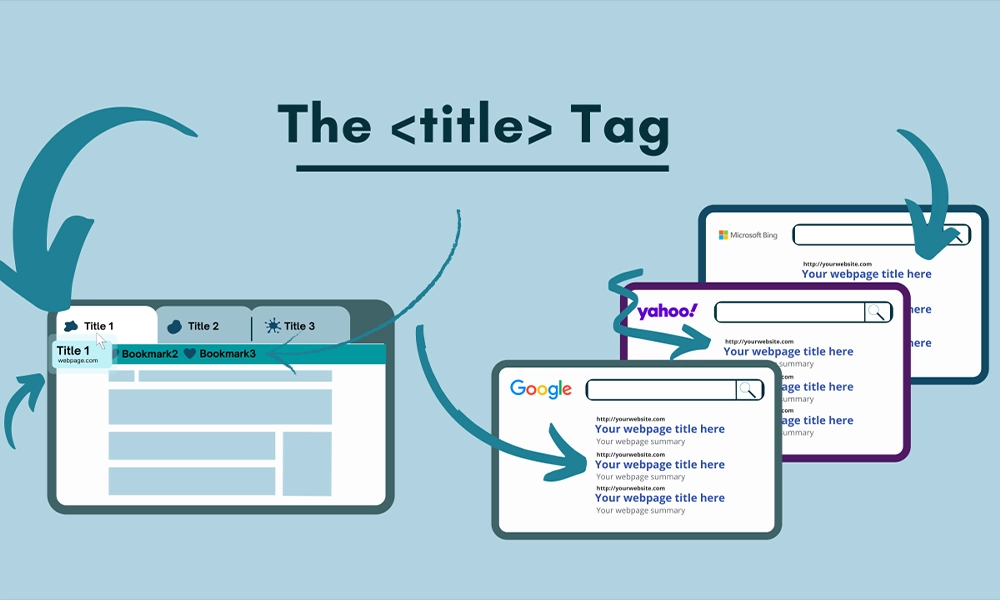What Are SEO Title Tags?
elements that define the title of a web page and are displayed in two key places: the browser tab and the search engine results page (SERP). The title tag appears as the clickable headline for a search result, making it one of the most important factors for both search engine rankings and user experience.
In essence, an SEO title tag serves as a brief, yet comprehensive, summary of a page’s content. It helps search engines understand the topic of the page, allowing them to index it properly, and it plays a significant role in enticing users to click on the link when it appears in the search results.

For instance, when someone searches for a specific query, the search engine looks at the title tags of relevant pages to determine which ones best match the user’s search intent. This makes SEO title tags a vital component of any successful SEO strategy, something Quanta agency specializes in
Key Components of an Effective SEO Title Tag:
- Relevance: The title must accurately reflect the content of the page. A title that’s misleading or irrelevant can result in a high bounce rate and lower rankings over time.
- Keyword Optimization: Including targeted keywords in your title tags is important, as search engines use them to understand the context of your page. While it’s important to use the keywords naturally, stuffing too many into a title tag can harm the user experience.
- Length: SEO title tags should generally be between 50-60 characters long. If a title is too long, it may get truncated in search results, making it less effective at conveying the message.
- Branding: Adding your brand name at the end of the title tag can help improve brand recognition and credibility. This is especially useful if your brand is well-known.
SEO title tags also impact your page’s click-through rate (CTR). An engaging and well-crafted title tag encourages users to click on your link over others. This higher engagement can indirectly affect search rankings by signaling to search engines that your page is relevant and useful to users. In the context of Generative engine optimization, crafting optimized title tags becomes even more crucial, as they contribute to a dynamic and evolving SEO strategy. In short, SEO title tags are more than just simple page titles; they are a key component of on-page SEO that influences both your website’s visibility in search results and your ability to attract clicks from potential visitors.
Why SEO Title Tags Matter
SEO title tags are a fundamental aspect of search engine optimization and play a pivotal role in how search engines understand and rank your web pages. Although they don’t directly influence rankings, they significantly affect a page’s click-through rate (CTR), which can, in turn, impact rankings. Here’s why SEO title tags matter:

- Search Engine Ranking: Title tags give search engines a clear indication of the content on your page. While the title tag itself isn’t a ranking factor, it helps search engines understand your content better and index it correctly. When search engines display your page in search results, the title tag is often the first thing users see, so getting it right can improve your chances of ranking higher.
- User Engagement and CTR: A well-crafted title tag encourages users to click on your page. It’s the first impression they have of your content, and a clear, compelling title tag can help differentiate your page from others in the search results. High CTR signals to search engines that your page is relevant and engaging, which can improve your page’s ranking over time.
- Relevance and User Intent: Title tags help you align your content with the search intent of your target audience. By including relevant keywords and phrases that match what users are searching for, you can better meet their needs and answer their questions, leading to higher engagement.
- Brand Awareness: Including your brand name in the title tag helps increase brand recognition, especially if you are a well-known brand. This can lead to more trust and clicks from users familiar with your brand.
In short, SEO title tags play a key role in attracting users, helping search engines understand your content, and ultimately boosting your site’s visibility in search results.
Best Practices for Writing SEO Title Tags
Writing effective SEO title tags is essential for improving your website’s visibility in search engine results and attracting more organic traffic. By following best practices for title tag optimization, you can ensure that your pages are both search engine-friendly and user-friendly. Here are some key guidelines for creating SEO title tags that perform well:
-
Include Primary Keywords
One of the most important aspects of an SEO title tag is the inclusion of relevant keywords. The primary keyword for the page should be placed toward the beginning of the title, as search engines tend to give more weight to the first few words. Make sure your title accurately reflects the content on the page while naturally incorporating the target keyword. However, avoid keyword stuffing, as it can negatively impact user experience and SEO.
-
Keep Title Length Between 50-60 Characters
Search engines typically display only the first 50-60 characters of a title tag in their search results. If your title tag exceeds this length, it may get cut off, making it less effective. To ensure your full title is visible, keep it within the optimal character range. This also makes it easier for users to read and understand the purpose of your page at a glance.
-
Write for Both Humans and Search Engines
While optimizing for search engines is important, your title tag should be written with users in mind as well. It should clearly convey the value of your content and entice users to click. A good title tag is clear, concise, and compelling. For example, if you’re writing about a product or service, highlight its benefits or key features in the title.
-
Use Branding Wisely
Including your brand name in the title tag can help improve brand recognition, especially if you’re a well-established company. If your brand name is recognizable, adding it to the end of the title tag can build trust and credibility with potential visitors. However, if you’re targeting a broader audience or focusing on SEO keywords, it may be more effective to leave the brand out in favor of keyword optimization.
-
Avoid Duplicate Titles
Each page on your website should have a unique title tag that accurately describes the content of that page. Duplicate title tags can confuse search engines and lead to lower rankings. To prevent this, ensure that every page has a distinct title that provides a unique value proposition.
-
Include Action-Oriented Language (If Relevant)
Adding action words or calls-to-action (CTAs) in your title tag can increase user engagement and improve your click-through rate (CTR). Phrases like “buy,” “learn,” “discover,” or “explore” can make the title more enticing and motivate users to click on the result.
-
Make It Descriptive and Informative
Your title tag should act as a concise summary of the content on the page. It should give users a clear idea of what they can expect if they click through. A descriptive title increases the likelihood of visitors finding your page relevant to their search, thereby improving your CTR and reducing bounce rates.
-
Use Numbers and Special Characters (When Appropriate)
Including numbers, percentages, or other symbols in your title tag can make it stand out in search results. Titles like “5 Tips for Effective SEO” or “Top 10 Marketing Strategies” tend to attract attention because they promise a list or specific information. However, don’t overuse special characters or make your title too cluttered, as this can harm its readability.
Table of Best Practices for Writing SEO Title Tags
|
Best Practice |
Explanation |
|
Primary Keywords |
Include relevant keywords at the beginning of the title. |
|
Length |
Keep the title between 50-60 characters to avoid truncation. |
|
Human & SEO-Friendly |
Write titles that are clear, concise, and appealing to users. |
|
Branding |
Add your brand name, especially if it’s recognized. |
|
Unique Titles |
Avoid duplicate titles across different pages. |
|
Action-Oriented Language |
Use CTAs like “buy,” “discover,” or “learn” to encourage clicks. |
|
Descriptive and Informative |
Make sure the title clearly summarizes the content. |
|
Numbers and Special Characters |
Use numbers or symbols to make the title more engaging. |
By following these best practices, you can ensure that your title tags are optimized for search engines and appealing to users, ultimately improving your website’s performance in search rankings and driving more organic traffic.
Common SEO Title Tag Mistakes to Avoid
Creating effective SEO title tags is essential for both improving search engine rankings and attracting users to your site. However, there are several common mistakes that can undermine the effectiveness of your title tags. Avoiding these mistakes can help improve both your SEO and user engagement. Here are some key mistakes to watch out for:
-
Keyword Stuffing
One of the most common mistakes is overloading the title tag with too many keywords. While it’s important to include relevant keywords, stuffing them in an unnatural or excessive way can negatively impact readability and user experience. Search engines might also penalize pages with keyword stuffing. Aim for a natural-sounding title that incorporates the keyword in a way that makes sense.
-
Duplicate Title Tags
Having duplicate title tags across multiple pages on your site can confuse search engines and negatively impact SEO. Every page should have a unique title that accurately describes the content on that page. If two or more pages share the same title tag, search engines may struggle to differentiate between them, leading to lower rankings.
-
Overly Long Titles
Title tags that exceed the recommended 50-60 characters can get cut off in search results, which may prevent users from seeing the full title. If the title is truncated, it may lose its appeal or important information. Make sure your title tags are concise yet descriptive enough to communicate the core message without being too long.
-
Ignoring User Intent
SEO title tags should reflect the user’s intent behind their search. Simply focusing on keywords without considering what the user is looking for can lead to poor performance. Ensure your title tags provide value and meet the expectations of users, helping them quickly understand what the page is about.
-
Missing or Poor Branding
Not including your brand name in the title tag, especially if it’s well-known, can be a missed opportunity for building brand recognition. While not necessary for every page, adding your brand to the title tag (usually at the end) can build credibility and trust.
By avoiding these common mistakes, you can create title tags that not only improve your SEO but also engage users and boost your website’s visibility in search results.
How to Optimize Existing SEO Title Tags
Optimizing your existing SEO title tags is an essential part of improving your website’s visibility and performance in search engine results. Here are some key steps to help you get the most out of your current title tags:
1. Review and Update Keywords
Start by reviewing your existing title tags to ensure they include the most relevant and high-performing keywords for each page. If your current keywords are outdated or not driving enough traffic, consider updating them with more targeted or trending terms. Use tools like Google Keyword Planner or SEMrush to find the best keywords for your audience.
2. Ensure Proper Length
Check the length of your title tags. Ideally, they should be between 50-60 characters. If your title tags are too long, they may get truncated in search results, leading to a poor user experience. Shorten or rewrite them to fit within the optimal character count while retaining essential information.
3. Add Branding (If Missing)
If your title tags don’t include your brand name, consider adding it—especially for high-traffic or branded pages. Including your brand can increase recognition and trust, which may improve your click-through rate (CTR).
4. Incorporate Action Words or CTAs
To increase user engagement, add action-oriented words like “buy,” “learn,” or “explore” to your title tags. This helps to entice users to click on your page, leading to higher CTRs.
5. Make Titles More Descriptive
Review the current titles to ensure they clearly describe the content on the page. Avoid vague or generic titles that don’t provide clear information. A more descriptive title can attract more relevant traffic and improve your page’s performance.
By following these steps, you can optimize your existing SEO title tags, ensuring they are aligned with current best practices and improving your site’s visibility and user engagement.
Advanced Tips for 2025 SEO Title Tag Optimization
In 2025, SEO title tag optimization is more crucial than ever. To ensure maximum visibility, focus on the following advanced tips:
- Include Primary Keywords Early: Position primary keywords near the beginning for better search engine recognition.
- Optimize for User Intent: Align the title tag with what users are searching for, reflecting clear intent.
- Use Numbers and Power Words: Incorporate numbers and compelling words to grab attention and increase click-through rates (CTR).
- Keep Length Balanced: Aim for 50-60 characters to avoid truncation in search results.
- Leverage Branding: Include your brand name at the end to build recognition, especially for branded searches.
- Avoid Keyword Stuffing: Focus on natural, user-friendly phrasing instead of overloading with keywords.
Examples of High-Converting SEO Title Tags
To capture more user attention and improve CTR, SEO title tags must include keywords, a value promise, and compelling language. This directly impacts the SEO conversion rate, as better-optimized title tags encourage higher click-throughs. Here are examples of high-converting title tags:
- “Best SEO Strategies for 2025: Boost Your Rankings Fast” – Using words like “Best” and “Boost” creates urgency and grabs attention.
- “How to Increase Website Traffic: 7 Proven Tips for Success” – Offering “7 Proven Tips” builds trust with the audience and encourages more clicks.
- “Top 10 Digital Marketing Tools You Can’t Miss in 2025″ – Numbers and words like “Can’t Miss” make the title more enticing.
- “Ultimate Guide to SEO for Beginners: Master SEO in 2025″ – The promise of mastering SEO for beginners makes the guide appealing to new users.
- “Affordable Web Design Services: Quality Websites at Low Prices” – The combination of “Affordable” and “Quality” appeals to cost-conscious users.
Tools to Help You Write Better SEO Title Tags
To craft optimized title tags, there are several powerful tools that can help:
- Yoast SEO – A popular WordPress plugin that helps optimize title tags and meta descriptions effectively.
- SEMrush – A competitor analysis tool that suggests keywords and phrases for improving your title tags.
- Moz Title Tag Preview Tool – Helps you see how your title will appear in search results, avoiding truncation.
- Google Keyword Planner – A tool to find high-performing and relevant keywords for your title tags.
- Ubersuggest – Suggests trending and relevant keywords that you can use to optimize your title tags.
These tools make it easier to write optimized, high-converting SEO title tags.










